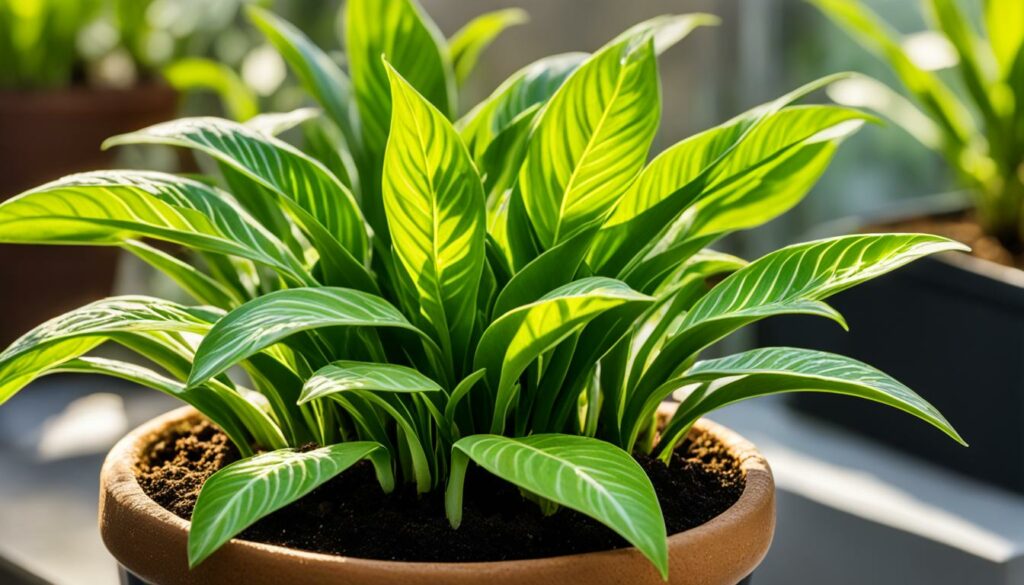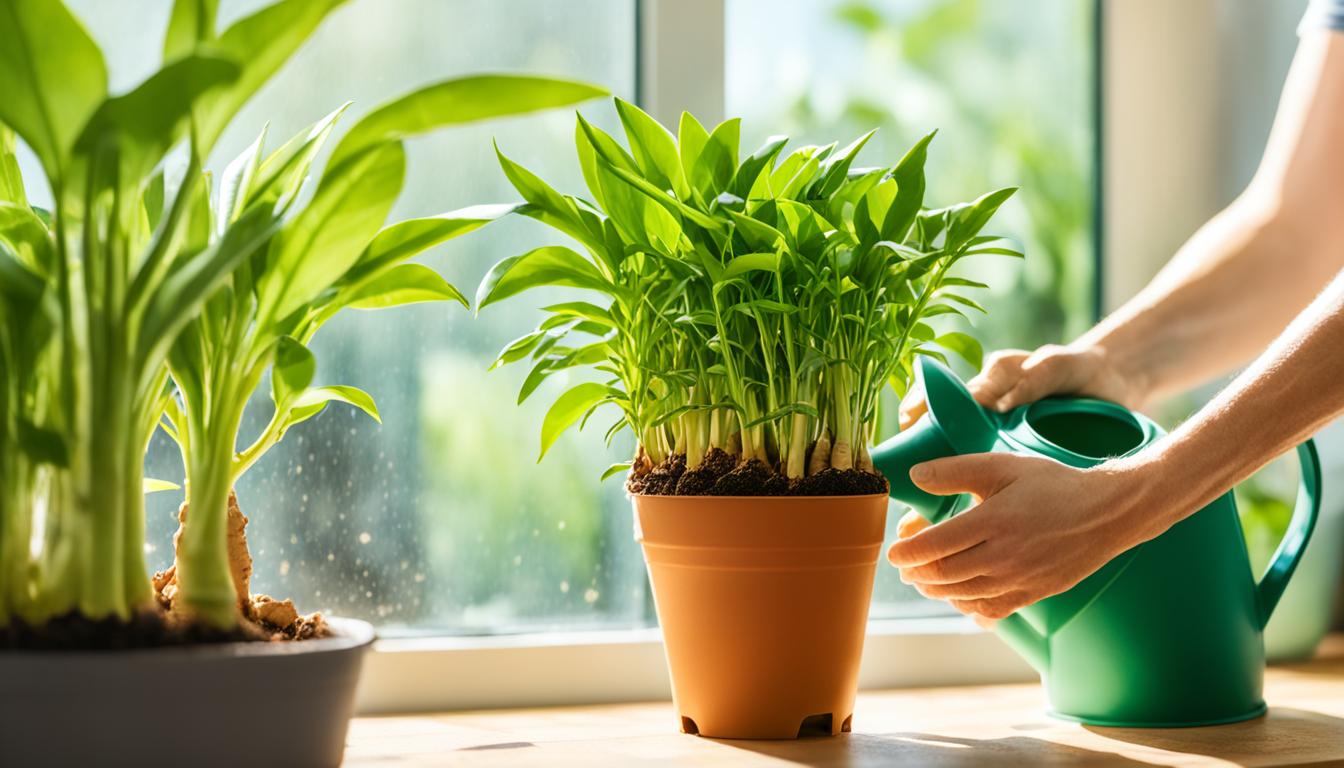Container Gardening: How to Grow Ginger Easily at Home
[et_pb_section fb_built=”1″ _builder_version=”3.22″][et_pb_row _builder_version=”3.25″ background_size=”initial” background_position=”top_left” background_repeat=”repeat”][et_pb_column type=”4_4″ _builder_version=”3.25″ custom_padding=”|||” custom_padding__hover=”|||”][et_pb_text _builder_version=”4.8.1″ background_size=”initial” background_position=”top_left” background_repeat=”repeat” custom_margin=”||38px|||”]
Ginger is such a versatile and healthy ingredient to keep in your kitchen, so learn how to grow ginger easily at home. I mean, most of us are using it in our cooking anyway, so why not just grow it yourself, have it fresh and readily available, and know that it hasn’t been sprayed or preserved with poisonous chemicals.
Besides ginger enhancing the flavor of your favorite dishes, it is also a rich source of antioxidants and anti-inflammatory compounds, ginger has a lot to offer. Plus, it’s an easy one to easily incorporate ginger into your sustainable gardening practices.
Discover the best container choices, learn planting and care tips, and get ready to enjoy the pleasure of harvesting your own fresh ginger. Let’s dive into the world of container gardening and unlock the secrets of growing ginger in your own home.
[/et_pb_text][et_pb_text admin_label=”Ginger varieties” _builder_version=”4.8.1″ background_size=”initial” background_position=”top_left” background_repeat=”repeat” custom_margin=”||38px|||”]
Ginger Varieties
Since this is a blog about growing your own food, I’m only going to mention a couple of the ginger varieties that are likely to use in cooking. After all, you’re probably going to get your ginger rhizome from your local store and grow from that, anyway.
When you are choosing ginger rhizomes, look for plump and juicy pieces with visible growing points or nubs. Here are some popular culinary ginger varieties:
> Common ginger: Flavorful with a zesty kick, commonly used in cooking and for herbal remedies.
> Cardamom ginger: Intensely aromatic and flavorful, commonly used in cooking and baking.
By selecting the right container and ginger variety, you can create an ideal environment for successful ginger cultivation in pots. Next, we’ll explore the planting and care tips to ensure your ginger plant thrives.
[/et_pb_text][et_pb_text _builder_version=”4.8.1″ background_size=”initial” background_position=”top_left” background_repeat=”repeat” custom_margin=”||38px|||”]
Choosing the Right Container
When selecting a container for ginger cultivation, opt for a wide and shallow pot. This will provide enough space for the ginger rhizomes to grow horizontally.
Aim for a depth of 8-12 inches, as ginger rhizomes do not require deep planting.

[/et_pb_text][et_pb_text admin_label=”Planting and Care Tips for Ginger in Containers” _builder_version=”4.8.1″ background_size=”initial” background_position=”top_left” background_repeat=”repeat” custom_margin=”||38px|||” hover_enabled=”0″ sticky_enabled=”0″]
Planting and Care Tips for Ginger in Containers
Successfully growing ginger in containers requires proper planting techniques and diligent care. By following these tips, you can ensure your ginger plants thrive and provide you with a bountiful harvest of delicious and aromatic ginger roots.
Soaking the Rhizomes
Prior to planting ginger in a pot, it is beneficial to soak the rhizomes overnight. This soaking process helps remove any growth inhibitors that may have been applied to store-bought ginger, ensuring optimal growth. however, this actually isn’t necessary, and your ginger will grow without you soaking it.
[/et_pb_text][et_pb_image _builder_version=”4.8.1″ _module_preset=”default” title_text=”Rhizome with new shoot 2″ src=”https://www.urban-gardener.co.za/wp-content/uploads/2024/04/Rhizome-with-new-shoot-2.jpg” hover_enabled=”0″ sticky_enabled=”0″ admin_label=”Image – rhizome with new shoot”][/et_pb_image][et_pb_text admin_label=”Continued” _builder_version=”4.8.1″ background_size=”initial” background_position=”top_left” background_repeat=”repeat” custom_margin=”||38px|||” hover_enabled=”0″ sticky_enabled=”0″]
This rhizome started to sprout in my cupboard, and since it’s looking very much on the dry side, I’m going to soak it for a few hours.
[/et_pb_text][et_pb_text admin_label=”Continued” _builder_version=”4.8.1″ background_size=”initial” background_position=”top_left” background_repeat=”repeat” custom_margin=”||38px|||” hover_enabled=”0″ sticky_enabled=”0″]
Choosing the Right Soil
When selecting soil for your ginger plants, opt for a loose and well-draining mixture. Simply mix up potting soil with an organic compost that you can buy or make your own vermicompost.
Mix about 70% compost, 10% coconut coir, and 20% potting soil.
This type of soil prevents water from becoming trapped around the roots, reducing the risk of root rot.
Proper Planting Technique
When planting ginger in a container, it does not matter where the ‘eyes’ are – they don’t have to point upwards like potatoes. Nature will do its thing and what needs to grow upwards, will grow upwards.
Plant one rhizome per pot, or if you have a large pot, leave about 20cm/ 8 inches between rhizomes. Cover with an inch of soil (about 3 cm).
If it’s too close to the surface, the rhizome will dry out. If it’s buried too deep, it will have a hard time to reaching the sun.
Sprinkle some bonemeal on the top of the soil and add organic mulch. Then water.
[/et_pb_text][et_pb_text admin_label=”Planting and Care Tips continued” _builder_version=”4.8.1″ background_size=”initial” background_position=”top_left” background_repeat=”repeat” custom_margin=”||38px|||” hover_enabled=”0″ sticky_enabled=”0″]
Best Time to Plant
Mid-spring is the best time to plant your ginger rhizome, as it will then grow fully during summer.
Light and Water Requirements
Ginger plants thrive in sunny conditions. Ensure your container is placed in an area that receives adequate sunlight, minimum 6 hours per day. BUT if the days are consistently hot, move it to partial shade or it will suffer leave burn. You can water the leaves as well if it’s too hot.
Additionally, provide regular watering, keeping the soil evenly moist at all time and do not let it dry out.
But also do not overly saturate. This helps prevent root rot and ensures optimal growth.
Humidity
Ginger plants thrive in high humidity environments. Aim to maintain humidity levels between 70-90% to create an ideal growing condition for your ginger. If your indoor environment is dry, consider using a humidifier or placing the container on a tray filled with water and pebbles to increase humidity.
If you need to bring your ginger plant inside when it gets cold, you can also use a grow tent or small miniature greenhouse that you can make yourself.
By following these planting and care tips, you can enjoy the rewards of growing ginger in containers.
[/et_pb_text][et_pb_text admin_label=”H2 – Conclusion” _builder_version=”4.8.1″ _module_preset=”default”]
Conclusion
[/et_pb_text][et_pb_text _builder_version=”4.8.1″ background_size=”initial” background_position=”top_left” background_repeat=”repeat” custom_margin=”||38px|||”]
Growing ginger in a container is a sustainable and beginner-friendly gardening practice that offers a range of benefits for your health and wellness. By following these simple mom gardening tips, you can successfully grow and harvest ginger at home, adding a fresh and flavorful touch to your culinary creations.
Discover the health benefits of ginger firsthand as you nurture your plants and watch them thrive. From its natural immune-boosting properties to its anti-inflammatory effects, ginger offers a wide range of wellness advantages. Whether you’re a gardening beginner or a seasoned green thumb, indoor herb gardening with ginger is an enjoyable and enriching experience that promotes your overall well-being.
[/et_pb_text][et_pb_text admin_label=”H2 – FAQs” _builder_version=”4.8.1″ _module_preset=”default”]
FAQs
[/et_pb_text][et_pb_text _builder_version=”4.8.1″ _module_preset=”default”]
Why should I grow ginger in a container instead of in my garden?
Growing ginger in a container allows you to have fresh ginger year-round, regardless of your gardening space. It is especially beneficial for urban and indoor gardening, where garden beds may not be available. Container gardening also gives you control over the soil quality and conditions, ensuring optimal growth for your ginger plants.
[/et_pb_text][et_pb_text _builder_version=”4.8.1″ _module_preset=”default” custom_padding=”37px|||||”]
What kind of container should I choose for growing ginger?
For growing ginger, choose a wide and shallow pot with a depth of 8-12 inches. This allows the ginger rhizomes to spread horizontally.
[/et_pb_text][et_pb_text _builder_version=”4.8.1″ _module_preset=”default” custom_padding=”37px|||||”]
What type of ginger should I choose for container gardening?
There are several ginger varieties suitable for container gardening, including Common ginger, Shell ginger, and Cardamom ginger. These varieties are popular for their culinary uses and can be easily grown in containers.
[/et_pb_text][et_pb_text _builder_version=”4.8.1″ _module_preset=”default” custom_margin=”26px|||||” custom_padding=”37px|||||”]
How do I plant ginger in a container?
Before planting ginger, soak the rhizomes overnight to remove any growth inhibitors. You can also allow the ends to heal over to prevent root rot. Use loose and well-draining soil that is organically rich, with a slightly acidic pH between 5.5-6.5. Plant the ginger rhizomes in the container with the eyes facing upward, ensuring they are just covered with about an inch of soil.
[/et_pb_text][et_pb_text _builder_version=”4.8.1″ _module_preset=”default” custom_padding=”38px|||||”]
What kind of care does ginger in containers require?
Ginger plants require full sun and regular watering. However, be cautious not to oversaturate the soil as it can lead to root rot. Additionally, maintain humidity levels between 70-90% for optimal growth.
[/et_pb_text][et_pb_text _builder_version=”4.8.1″ _module_preset=”default” custom_padding=”35px|||||”]
Can beginners grow ginger in containers?
Absolutely! Growing ginger in containers is a beginner-friendly gardening practice. With the right container, soil, and care, you can successfully cultivate ginger at home. It’s a great way to learn about organic gardening practices and start your herb gardening journey.
[/et_pb_text][et_pb_text _builder_version=”4.8.1″ _module_preset=”default” custom_padding=”38px|||||”]
What are the health benefits of ginger?
Ginger has numerous health benefits, including reducing nausea, aiding digestion, and reducing inflammation. It is also rich in antioxidants and has potential anti-cancer properties. Adding freshly harvested ginger to your cooking and wellness routine can provide these health benefits.
[/et_pb_text][et_pb_text _builder_version=”4.8.1″ _module_preset=”default” custom_padding=”37px|||||”]
Can I use ginger leaves and stems in cooking?
While the main focus of ginger cultivation is the rhizomes, the leaves and stems of ginger plants can also be used in cooking. They have a mild ginger flavor and can be used as a garnish or added to soups, stews, and stir-fries for extra flavor.
[/et_pb_text][/et_pb_column][/et_pb_row][/et_pb_section]
